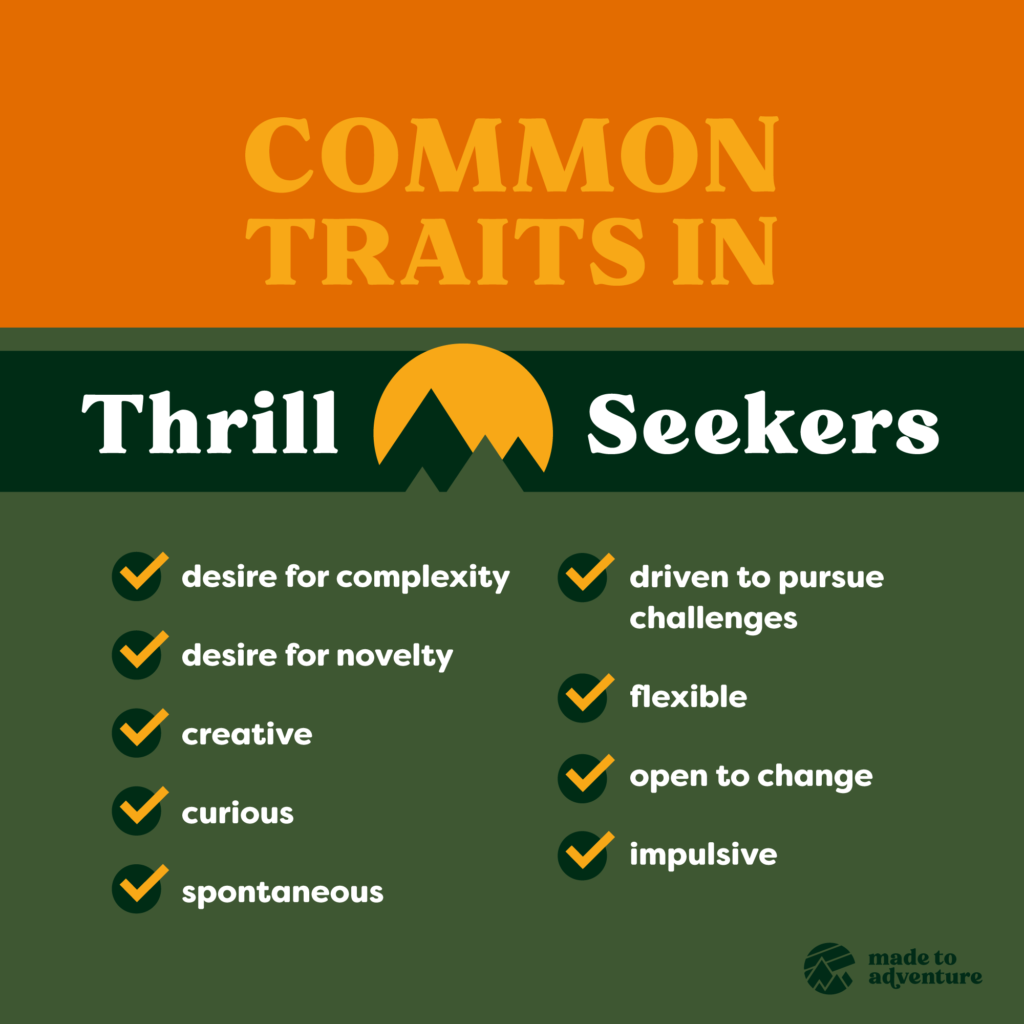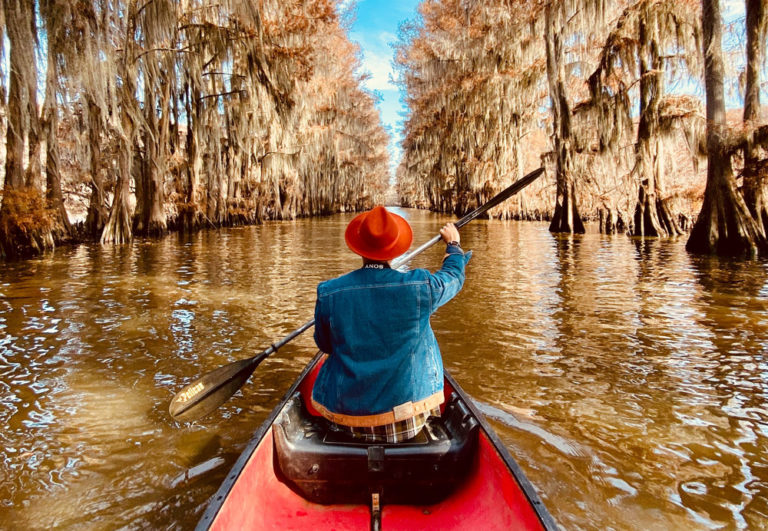Why do some people feel like they need to take extreme risks in life? What is that thing inside them that yearns for more?
Some of us seek out adventure more than others – that much is clear. Does that mean we’re wired differently? Is there a scientific explanation behind the behavior some people consider reckless and others can’t seem to get enough of?
We’re jumping into the deep end – right into the science and psychology behind what drives adventure seekers in such powerful, even addictive ways.
Get ready to learn more than you probably ever wanted to know on the topic. *Wink*
TABLE OF CONTENTS
Chapter 1: Redefining “Adventure”
Chapter 2: The Science Behind Why We Seek Adventure
Chapter 3: Thrill Seeking Is Highly Addictive
Chapter 4: Genetics Can Play a Role in Risky Behavior
Chapter 5: The State of Flow [Getting in the Zone]
Conclusion: What to Do When You Hear “The Call to Adventure”
Redefining Adventure
“Adventure is defined by uncertain outcome, and uncertainty drives full engagement.”
Matt Walker, M.A.
We’ll start off by defining the ambiguous term “adventure.” That’ll be the definition used throughout the rest of this article (and across the blog).
Adventure involves not knowing what’s coming next. And when we don’t know what’s coming, we naturally experience some degree of fear. That fear and uncertainty then drive our ability to focus – hone into the matter at hand – and fully engage with it. If this concept is true, then some possible antonyms of adventure might be predictability, safety, even boredom.
I understand adventure as the point where we reach the edge of our comfort zones and step into the unknown – into fear and total engagement. This is a place where we can find clarity, experience growth, and thrive.
One of the best parts of adventure? It can lead to freedom.
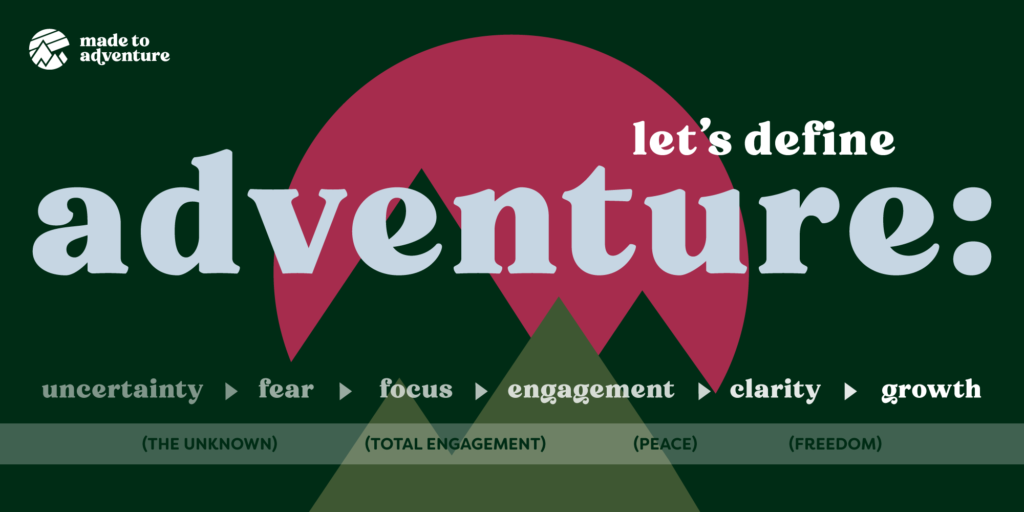
5 Elements of Adventure
We can define adventure in even greater depth using Matt Walker’s explanation. He’s a psychologist and the author of Adventure in Everything: How the Five Elements of Adventure Create a Life of Authenticity. He describes adventure as comprising five key elements.1
- High endeavor: The ability to think bigger regarding who you are, your lifestyle, and what you can achieve
- Total commitment: Being willing to embrace challenges with confidence and move toward success
- Uncertain outcome: Accepting that you will face adversity and discomfort (but these things present new opportunities)
- Tolerance for adversity: Resilience in the face of challenges
- Great companionship: Enhancing relationships with others through adventurous living
Let’s sum up. In this light, we can describe the concept of adventure as embracing a new challenge with some degree of positivity and confidence, accepting that we’ll face some discomfort as we do. Some natural outcomes will be newfound resilience in the face of future challenges and forging meaningful friendships along the way. Ooh, I’m lovin’ that!
Fear vs. Terror
Now let’s address the elephant in the room: the fear vs. confidence part. How do we move past the fear and into the zone where we feel confident while facing uncertainty?
There’s a difference between getting to the edge of our comfort zones and being afraid of what comes next versus having anxiety and terror take over, leaving us frozen in our boots.
The former (fear) can lead to focus, clarity, and excitement as we accept the challenge before us. The latter (terror) can hijack us physically and emotionally.1
Accepting Uncertainty
Maybe one of the differences between those who thrive off adventure and those who avoid it like the plague comes down to how they deal with uncertainty. And for the record, the very same person can land in both camps at different times of their life.
If we can acknowledge our feelings of uncertainty, fear, and overwhelm and accept that we aren’t in control, we will shift toward peace and clarity.
Then we can take action.
This doesn’t only apply to the times we’re off gallivanting across Peru or deep-sea diving in Thailand. It also applies to our everyday lives – the challenges we face at home, work, and personally.
If we realize that we don’t control the outcome of events, we can become a more powerful influence on how certain circumstances in our lives play out. Or, at the very least, we can find peace as those events unfold.
Letting Go of What We Can’t Control
Focusing on what we can control – our own actions and intentions – and letting go of the rest will help us face challenges head-on. Some of the results may include greater awareness, more profound satisfaction, and deeper joy.
When we’re willing to embrace the unknown with peace and a willingness to learn, we can move forward with more confidence and kindness, giving ourselves and those around us the grace we all need to keep moving forward.
The Science Behind Why We Seek Adventure
Time to get to the meat and potatoes. Or, for the vegans out there, the beans and brussels sprouts. Here’s what’s going on in your brain and body while adventuring.
Neurotransmitters
When we work on a skill or a sport in a place we love, our brain releases neurotransmitters. These are often referred to as our “feel-good hormones,” helping us feel happy and even euphoric at times.
Dopamine, oxytocin, endorphins, and serotonin are the four main feel-good hormones. There are natural ways (diet, exercise, adventure) and unnatural ways (drugs, supplements) to boost these hormone levels in our bodies.
Let’s break each one down.
Dopamine
Dopamine is a neurotransmitter your body makes and your nervous system uses to send messages between nerve cells (WebMD). It helps you think, plan, focus, feel pleasure, and find things interesting. In short, it can give you an intense feeling of reward, also called a “dopamine rush.” Dopamine can also reinforce your desire to feel that “high” again.
Regarding adventure, researchers (David Zald and others) have found that humans who are more eager to take risks and be spontaneous have fewer dopamine-regulating receptors than their more cautious counterparts. So the brains of adventure seekers become more saturated with dopamine.
When someone has a novel experience that gives them a big dopamine rush, it creates a desire to keep returning for more. Plus, that “hit” can be bigger and more potent in the bodies of adventurers than in non-adventurous people (remember, fewer regulators = more dopamine).
Oxytocin
Oxytocin is commonly known as the love hormone, produced in the hypothalamus and then released into the bloodstream. It helps us bond with those we care about and gives us a greater sense of well-being. Conversely, low oxytocin levels may be linked to symptoms of depression.
Our bodies naturally produce this hormone through exercise, touch, music, and falling in love. Exercise is one of the best ways to boost this hormone.
Endorphins
When you experience stress or pain, your hypothalamus and pituitary gland will release endorphins for relief. These hormones are known as natural painkillers and mood boosters. Studies show that endorphins not only can help with anxiety and stress but also ease symptoms of depression, contribute to weight loss, and increase confidence.
One of the most effective ways to release more endorphins in your body is by exercising. Have you ever experienced a “runner’s high” or the like? Meditating, laughing, creating art, eating dark chocolate, and other activities can also give you a blast of endorphins.
Serotonin
Serotonin is produced in the center of the brainstem and affects various functions and behaviors, including how we respond to stress, addiction, breathing, sleep, body temperature, memory, fear, and more. This hormone helps us feel happy and euphoric. Like other feel-good hormones, low serotonin levels are linked to depression.
Again, exercise is a great way to increase your serotonin levels; it releases an amino acid your brain uses to produce more serotonin. Natural sunlight and artificial bright lights can also increase serotonin levels.
Adrenaline (Epinephrine)
We can’t leave this guy out when talking about adventure. Your adrenal glands are located just above your kidneys and produce a hormone called epinephrine (or adrenaline) when you experience fear or excitement. This can occur while you participate in a thrilling or intense activity. Epinephrine also puts you in “fight or flight” mode when you encounter or sense danger. The hormone triggers your body to release extra oxygen, allowing you to fight or flee as needed.
Epinephrine can trigger you to become highly aware, sharpen your mental focus, and increase your strength, all while decreasing your feelings of pain. No wonder so many people chase this high!
Thrill Seeking Is Highly Addictive
After reading through the previous section, it should be no surprise to hear that intense exercise and adventure can be highly addictive. There are many studies to back this claim.
Known as one of many “behavioral addictions,” adventure recreation can lead us to devote more time and resources to carry out our preferred activity at a higher skill level (involving greater physical risk) (Ralf C. Buckley).
According to a study of individuals performing high- and intermediate-level adventure activities, signs of addictive behavior include the following:2
- Identifying yourself through your preferred activity
- Choosing friends and partners from that same activity
- Spending a lot of money and discretionary time on adventure trips and equipment
- Judging yourself on adventure peer esteem
- Organizing your life to minimize other costs, saving money for your activity
- Life revolving around your preferred activity, spending a lot of time planning, selecting, and designing it
- Being preoccupied with the activity prior to participation and prioritizing it over other obligations
- Experiencing significant mood swings based on recent conditions or becoming emotionally immunized against negative emotions for hours or days
- Building a tolerance from continuous exposure to addictive behavior (In other words, as your skills and experience increase, you crave more difficult challenges to achieve the same emotional high.)
- Experiencing withdrawal symptoms (such as depression, anger, pain, palpitations, or perspiration) when your activity becomes unavailable
“Adventure aficionados become addicted to thrills, at least as strongly as participants become addicted to sports or exercise.”
Ralf C. Buckley.
At least sports, exercise, and adventure fall into the “positive” bucket of addictive behavior. “Antisocial” addictions include gambling and crime, and “neutral” activities encompass things like video games and internet use. Of course, participating in any activity can go south if we let things get out of control.
If you’re getting slightly uncomfortable, here’s some good news. Thrill-seeking behavior may be addictive, but it’s not officially classified as an addiction in the Diagnostic and Statistical Manual of Mental Disorders. And experts say it typically won’t become a problem unless you’re putting your life or the lives of others at stake or it’s interfering with your relationships or daily life.3
If you’re experiencing any of these circumstances, it may be time to take a step back – or call a therapist to work through a few things.
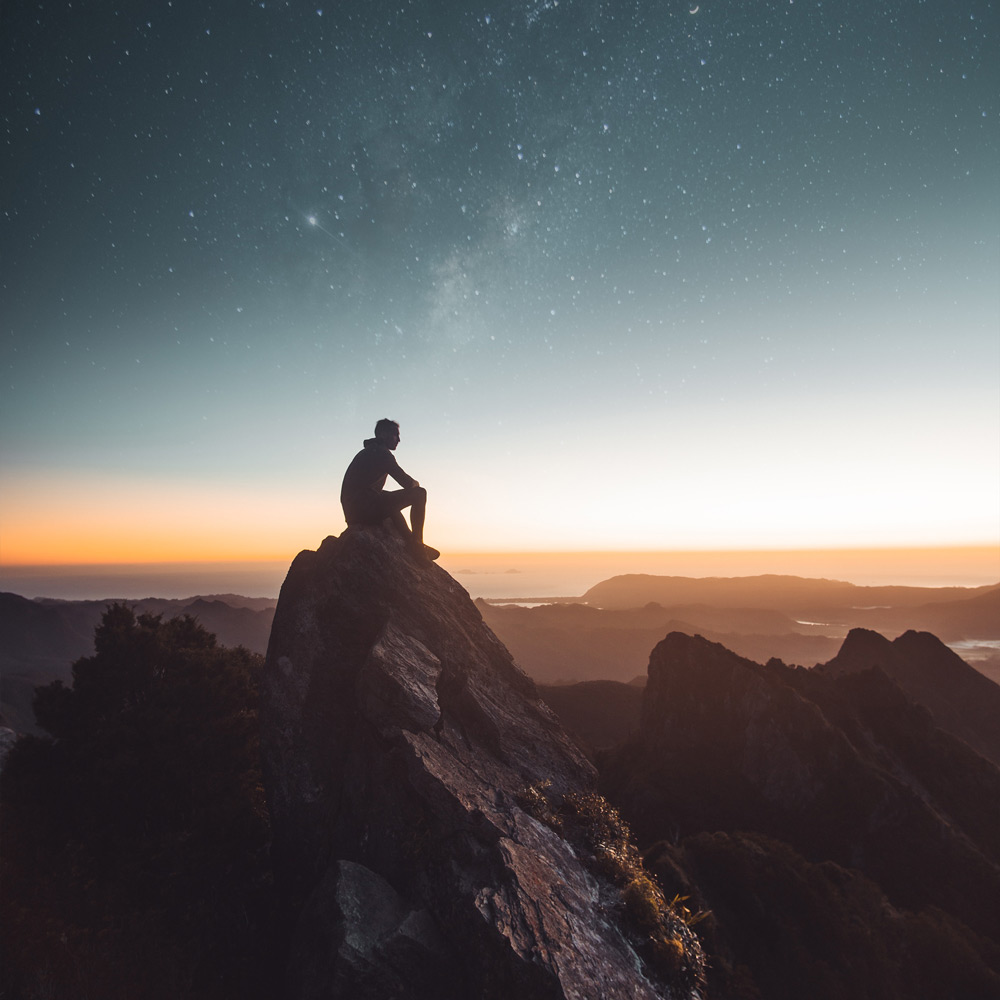
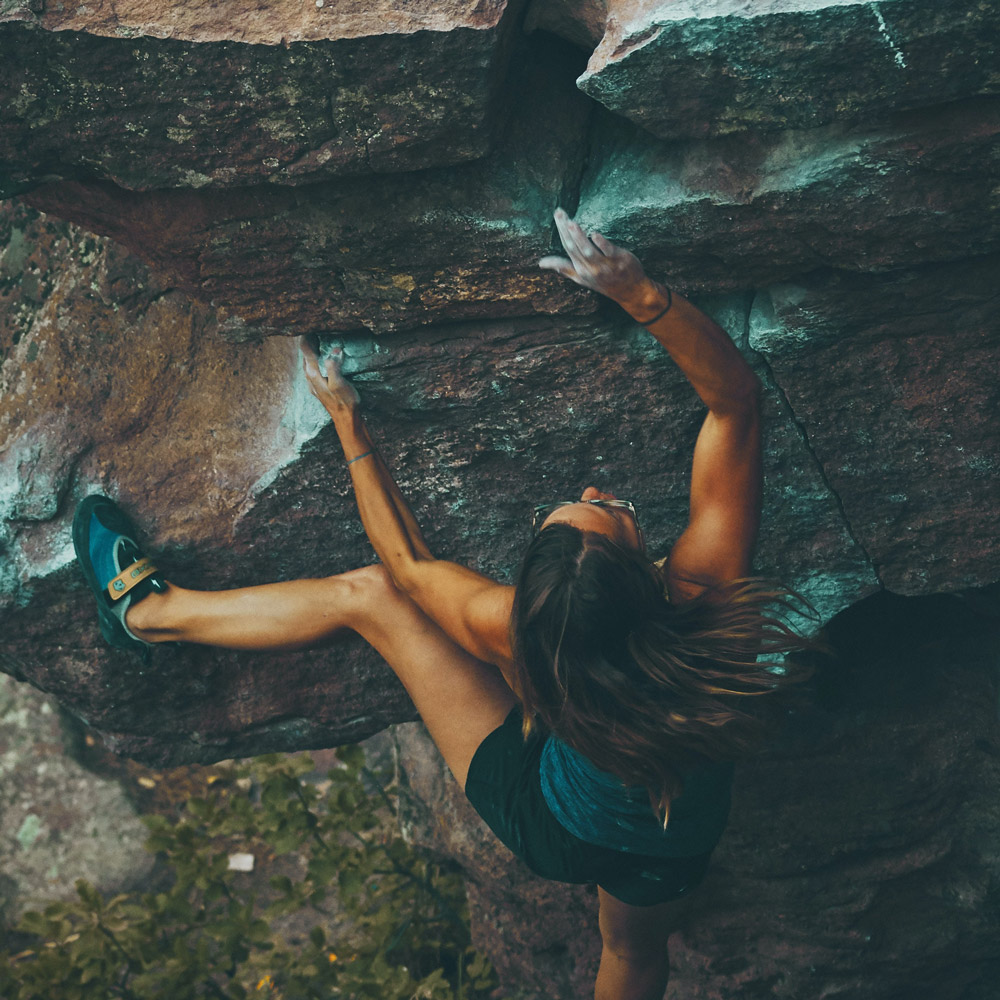
Genetics Can Play a Role in Risky Behavior
Do adventurous people have a different genetic makeup than those who avoid risk as much as possible? Let’s find out.
Risk-Taking & Genetics
“Risk-taking has value and serves an important evolutionary purpose. Without the courage to advance into unknown, potentially dangerous territory, humans may not have found new mates, populated the globe, or flourished as a species.” –Psychology Today
Risk-taking is in our genes and part of our biology – passed down to us by our ancestors. Those prone to taking risks may have had a better chance of surviving and, therefore, passing on their genetic traits.
“As our species evolved, communities with risk takers might have done better at things like warding off attackers… Risk taking was important for the species and the individual.”
Psychologist Thomas Crowley
Sensation Seeking
Psychologist Marvin Zuckerman believes personality traits are rooted in genes, biology, and persisting environmental interactions. “Risky behavior can be an expression of a normal, genetically influenced personality trait” called sensation seeking. In his book, Sensation Seeking and Risky Behavior, he connects sensation seeking with behaviors like engaging in extreme sports, risky driving, and substance abuse.
The Sensation Seeking Scale (SSS) is a test to assess your optimal level of stimulation, measuring four different factors: thrill and adventure seeking, experience seeking, disinhibition, and boredom susceptibility. We all sit somewhere along this spectrum. You can take the test to learn where you fall.
The Wanderlust Gene
A study published in the Psychological Science journal found a group of gene mutations that “help predict whether someone is inclined toward sensation seeking” (APS). Additionally, scientific studies have now connected novelty-seeking personality traits with DRD4-7R – a gene variant known as the wanderlust gene.
DRD4 controls our dopamine levels. And this variant (7R) correlates to lower dopamine sensitivity, which is found in those who display riskier behavior. (Remember what we said about dopamine earlier on?! It’s all coming together.) This behavior can include anything from traveling to using drugs to passion, restlessness, and curiosity. 1 in 5 people could have this mutation, playing a role in their thrill-seeking desires.4
Common Traits in Thrill Seekers
If you have these traits, you might be prone to seeking adventure and experiencing a rush of adrenaline (according to Healthline).
- You have a desire for complexity.
- You’re driven to pursue challenges.
- You’re creative.
- You’re curious.
- You desire novelty.
- You’re flexible and open to change.
- You’re spontaneous and impulsive.
Fun Fact: Procrastination might be a way for you to get your "adventure fix.” Waiting until the last minute to meet a deadline can trigger an adrenaline rush – giving you the thrill and energy needed to focus and finish strong.
The State of Flow [Getting in the Zone]
“When you’re in that moment, there’s no beginning and no end. It starts off where it left off. When you go to that place, there’s no time, and there’s definitely no thought. It’s just pure. You are, and it is, and that’s why we continually seek it out, and always search for it, and need it. We need to feel alive and to feel complete.”
Steve Kotler, The Rise of Superman
What is flow?
Through extensive research, flow has been shown to help people reach peak performance – not just in sports but in business and other activities as well. In fact, a 10-year study showed that people in flow states are 500% more productive!
Wow. So how do we reach this magical place?
According to a psychologist named Csikszentmihalyi (try saying that out loud), who developed a flow state theory and the model below, entering this state requires two things:
- Balancing challenges/action opportunities with individual skill
- Balancing clear, well-defined goals with immediate feedback
As the complexity of our skill increases, the complexity of the task’s challenge must also increase. This balance results in flow. On the other hand, an off-balance scale can result in apathy or boredom.5
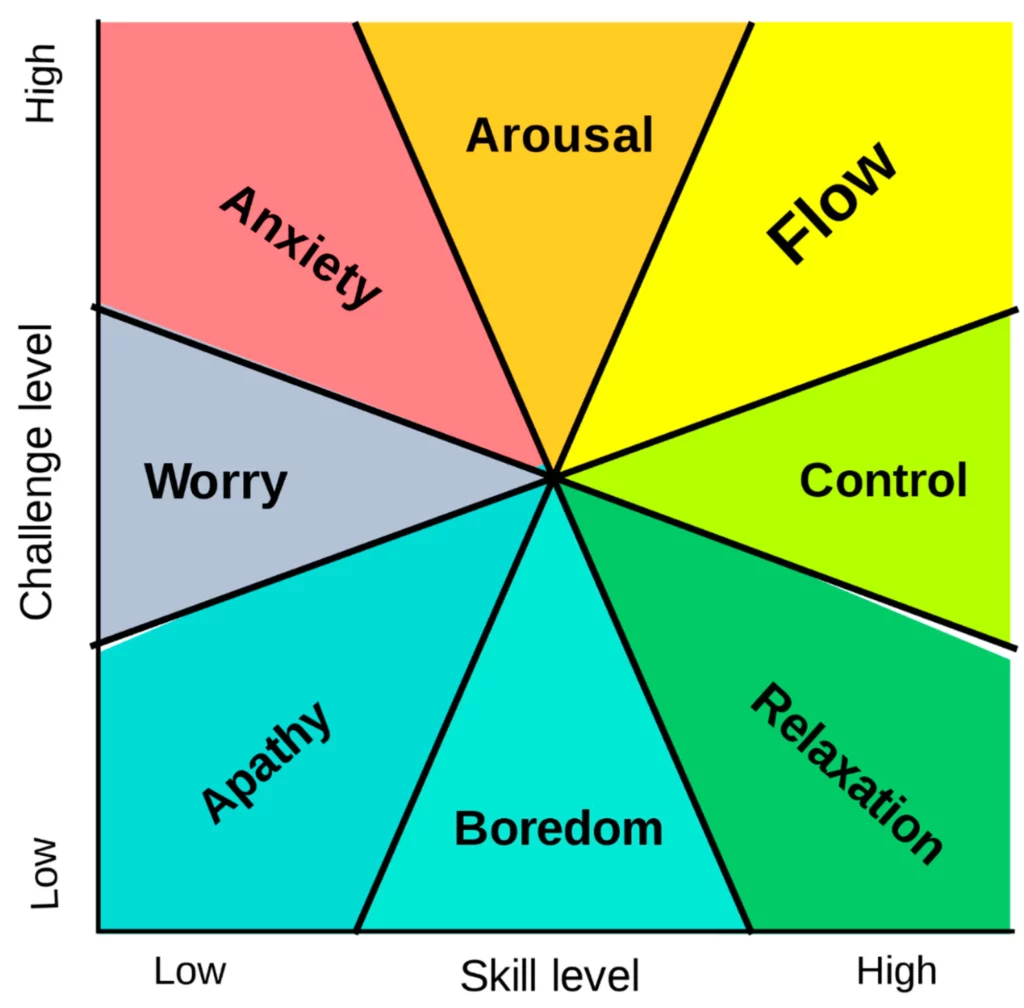
Source: MDPI
“In flow, every action, every decision, leads effortlessly, fluidly, seamlessly to the next. It’s high-speed problem solving; it’s being swept away by the river of ultimate performance.”
Steven Kotler
For the people in the back. Flow is the state of mind you’re in when you’re entirely immersed in an activity. You’re totally focused and engrossed in your work. This state can help you feel more energized and have greater enjoyment and higher involvement.
How do you enter a flow state?
Flow experiences commonly occur when you’re doing something you enjoy and are skilled at. Painting, writing, music, and drawing are good examples, as are running, rock climbing, and swimming.
Don’t expect to enter this ideal state in your everyday life, though – where skills and challenges are rarely balanced. In fact, achieving the balance we covered earlier doesn’t always swing it. Your chosen activity must also meet the following criteria:
- The learning of skills
- Clear goals with quick/unambiguous feedback

Source: MDPI
How does it feel?
“The ego falls away. Time flies. Every action, movement, and thought follows inevitably from the previous one, like playing jazz. Your whole being is involved, and you’re using your skills to the utmost.”
In a state of flow, you can expect to become so absorbed in a task that you can’t spare any of your attention. You’re fully engaged. Distractions don’t exist. You feel in control, may lose track of time, lose self-consciousness and thoughts of daily problems, and feel like you’ve transcended to a place of unity with the activity.
This is known to many as the Holy Grail of performance.5
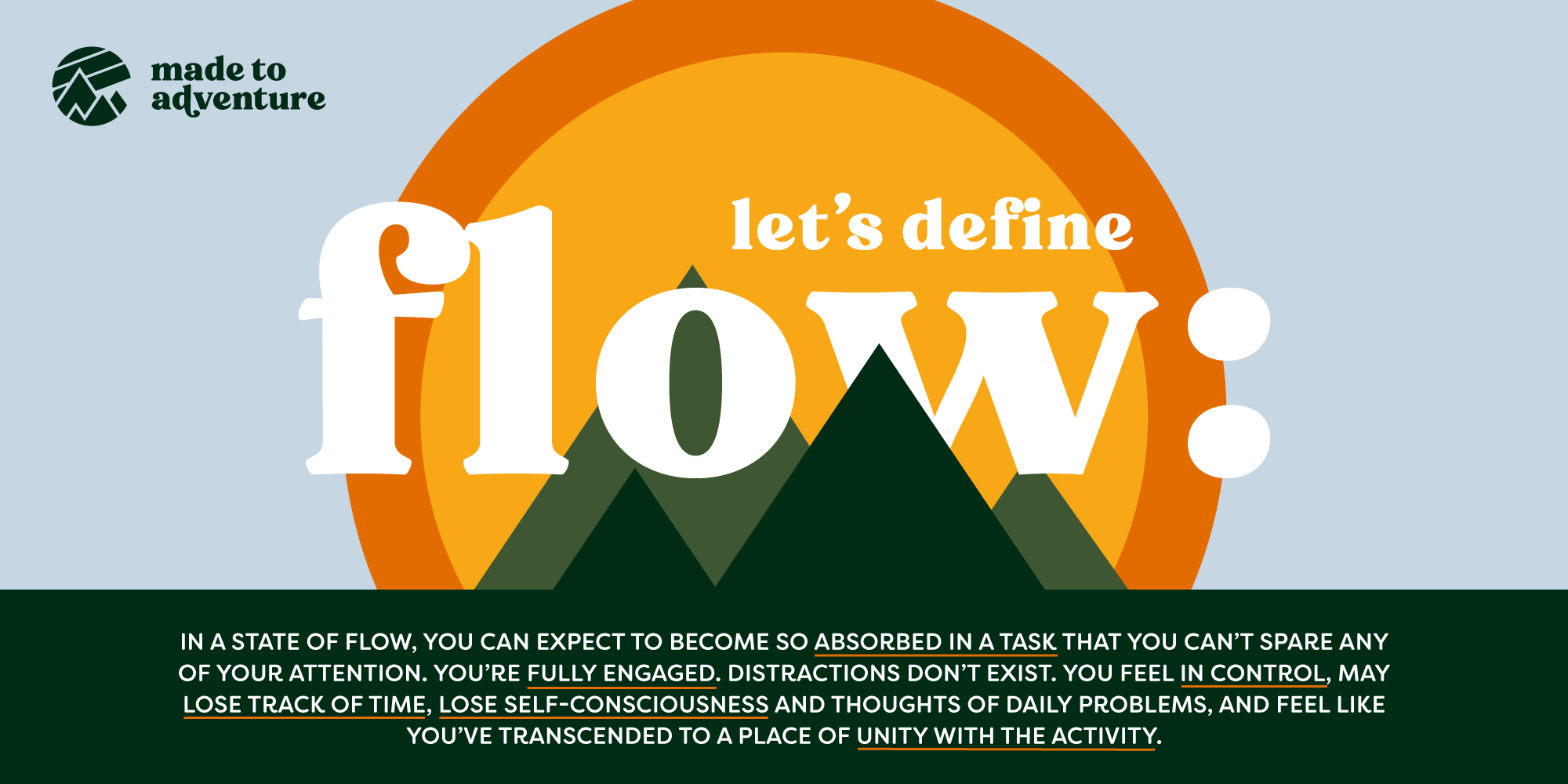
There are several advantages to experiencing flow:6
- Developing skills that help you better regulate your emotions
- Enjoying the activity more and find it more fulfilling and rewarding
- Increasing intrinsic motivation
- Mastering skills and inspiring creativity
- Enhancing your performance in other areas, such as learning, artistic creativity, athletics, and teaching
What to Do When You Hear “The Call to Adventure”
Wow, we covered a lot in this article. Hopefully you feel encouraged – even jazzed – to pursue the adventurous life you’re being called to. I believe that we won’t only learn and grow throughout our journeys. We’ll also become more of who we were created to be in the first place. We’ll become more authentic as we learn to better love ourselves, our lives, and those who join us along the way.
In storytelling, “the call to adventure” comes near the beginning of the story. It’s part of the hero’s journey (remember high school English class?). The protagonist faces a challenge and must either ignore or accept the call.
Think of Bilbo Baggins when Gandalf first approaches him and asks if he’ll participate in a vital mission. At first, Bilbo refuses, not wanting to leave the comfort of home and being afraid of the risks involved. Then he starts considering. He finally accepts, heads out the door, and sets off on an adventure of a lifetime.
Something inside him longed for more – and accepting the call changed him forever.
Next time you hear the call to adventure, I encourage you to move toward it. See if there might be something in it for you.
And in case you’re wondering, chasing adventure isn’t just “selfish,” either. In fact, it can make you more wholly yourself and, therefore, better able to show up for others in this journey called life. It can help you build trust with yourself, become more confident and empathetic, take on challenges with a deep sense of peace, and encourage those around you.
So I want to leave you with one final question.
What if accepting the call to adventure leads to a richer, more joyful, fulfilling, and purpose-filled life?
All that might be worth the risk, don’t you think?
1. Walker , Matt. “Be Very Afraid: Uncertainty, Fear, and Achievement.” Psychology Today, Sussex Publishers, 18 May 2015, https://www.psychologytoday.com/us/blog/adventure-in-everything/201505/be-very-afraid-uncertainty-fear-and-achievement.
2. Buckley, Ralf C. “Adventure Thrills Are Addictive.” Frontiers, Frontiers Media S.A., 27 Nov. 2015, https://www.frontiersin.org/articles/10.3389/fpsyg.2015.01915/full.
3. Raypole, Crystal. “Adrenaline Junkie: What Is It, and Could You Be One?” Healthline, Healthline Media, 31 May 2019, https://www.healthline.com/health/adrenaline-junkie.
4. Christou, Luke. “What Is DRD4-7R, the Wanderlust Gene Linked with Excitement and Adventure?” Verdict, 8 Sept. 2017, https://www.verdict.co.uk/drd4-7r-wanderlust-gene/.
5. Gold, Joshua, and Joseph Ciorciari. “A Review on the Role of the Neuroscience of Flow States in the Modern World.” MDPI, Multidisciplinary Digital Publishing Institute, 9 Sept. 2020, https://www.mdpi.com/2076-328X/10/9/137.
6. Cherry, Kendra. “What Is a State of Flow?” Verywell Mind, Dotdash Meredith, 11 Nov. 2022, https://www.verywellmind.com/what-is-flow-2794768.

